Lyons W.C. (ed.). Standard handbook of petroleum and natural gas engineering.2001- Volume 1
Подождите немного. Документ загружается.

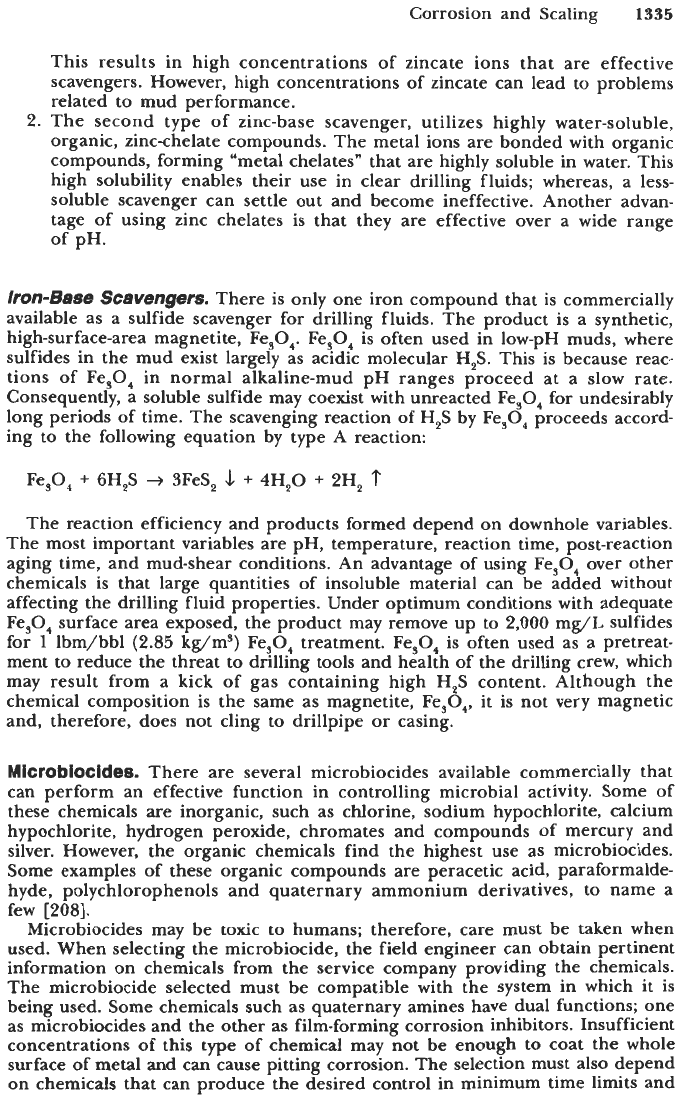
Corrosion and Scaling
1335
2.
This results in high concentrations of zincate ions that are effective
scavengers. However, high concentrations of zincate can lead to problems
related to mud performance.
The second type of zinc-base scavenger, utilizes highly water-soluble,
organic, zinc-chelate compounds. The metal ions are bonded with organic
compounds, forming "metal chelates" that are highly soluble in water. This
high solubility enables their use in clear drilling fluids; whereas, a less-
soluble scavenger can settle out and become ineffective. Another advan-
tage of using zinc chelates is that they are effective over a wide range
of
pH.
IfOmB8Se
SC8VengerS.
There is only one iron compound that is commercially
available as a sulfide scavenger for drilling fluids. The product is a synthetic,
high-surface-area magnetite, Fe,O,. Fe,O, is often used in low-pH muds, where
sulfides in the mud exist largely as acidic molecular
H,S.
This is because reac-
tions
of
Fe,O, in normal alkaline-mud pH ranges proceed at
a
slow rate.
Consequently, a soluble sulfide may coexist with unreacted Fe,O, for undesirably
long periods of time. The scavenging reaction of
H,S
by Fe,O, proceeds accord-
ing to the following equation by type
A
reaction:
Fe90,
+
6H,S
+
3FeS,
5
+
4H,O
+
2H,
t
The reaction efficiency and products formed depend on downhole variables.
The most important variables are pH, temperature, reaction time, post-reaction
aging time, and mud-shear conditions, An advantage of using Fe,O, over other
chemicals is that large quantities of insoluble material can be added without
affecting the drilling fluid properties. Under optimum conditions with adequate
Fe,O, surface area exposed, the product may remove up
to
2,000
mg/L sulfides
for
1
lbm/bbl
(2.85
kg/m3) Fe,O, treatment. Fe,O, is often used as a pretreat-
ment to reduce the threat to drilling tools
and
health of the drilling crew, which
may result from a kick of gas containing high H,S content. Although the
chemical composition is the same as magnetite, Fe,O,, it is not very magnetic
and, therefore, does not cling to drillpipe or casing.
Microbiocides.
There are several microbiocides available commercially that
can perform an effective function in controlling microbial activity. Some
of
these chemicals
are
inorganic, such as chlorine, sodium hypochlorite, calcium
hypochlorite, hydrogen peroxide, chromates and compounds of mercury and
silver. However, the organic chemicals find
the
highest use as microbiocides.
Some examples
of
these organic compounds are peracetic acid, paraformalde-
hyde, polychlorophenols and quaternary ammonium derivatives,
to
name a
few
[208].
Microbiocides may be toxic to humans; therefore, care must be taken when
used. When selecting the microbiocide, the field engineer can obtain pertinent
information on chemicals from the service company providing the chemicals.
The microbiocide selected must be compatible with the system in which it is
being used. Some chemicals such as quaternary amines have dual functions; one
as microbiocides and the other as film-forming corrosion inhibitors. Insufficient
concentrations
of
this
type
of chemical may not be enough
to
coat the whole
surface of metal and can cause pitting corrosion. The selection must also depend
on chemicals that can produce the desired control in minimum time limits
and
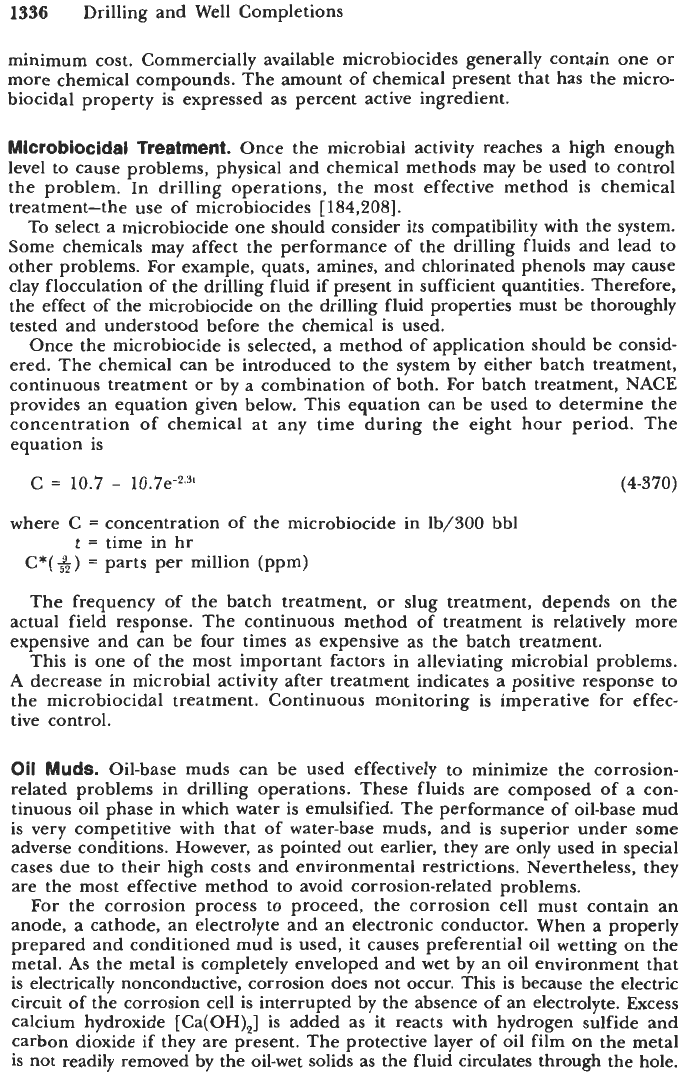
1336
Drilling and Well Completions
minimum cost. Commercially available microbiocides generally contain one
or
more chemical compounds, The amount of chemical present that has the micro-
biocidal property is expressed as percent active ingredient.
Microblocidal
Treatment.
Once the microbial activity reaches a high enough
level to cause problems, physical and chemical methods may be used to control
the problem. In drilling operations, the most effective method is chemical
treatment-the use of microbiocides
[
184,2081.
To
select a microbiocide one should consider its compatibility with the system.
Some chemicals may affect the performance of the drilling fluids and lead to
other problems. For example, quats, amines, and chlorinated phenols may cause
clay flocculation of the drilling fluid if present in sufficient quantities. Therefore,
the effect of the microbiocide on the drilling fluid properties must be thoroughly
tested and understood before the chemical is used.
Once the microbiocide is selected, a method of application should be consid-
ered. The chemical can be introduced to the system by either batch treatment,
continuous treatment or by a combination of both.
For
batch treatment, NACE
provides an equation given below. This equation can be used to determine the
concentration of chemical at any time during the eight hour period. The
equation is
C
=
10.7
-
10.7e-2.3t
(4-370)
where C
=
concentration
of
the microbiocide in lb/300 bbl
t
=
time in hr
C*(
4)
=
parts per million (ppm)
The frequency of the batch treatment,
or
slug treatment, depends on the
actual field response. The continuous method of treatment is relatively more
expensive and can be four times as expensive as the batch treatment.
This is one
of
the most important factors in alleviating microbial problems.
A
decrease in microbial activity after treatment indicates a positive response to
the microbiocidal treatment. Continuous monitoring is imperative for effec-
tive control.
Oil
Muds.
Oil-base muds can be used effectively to minimize the corrosion-
related problems in drilling operations. These fluids are composed of
a
con-
tinuous oil phase in which water is emulsified. The performance of oil-base mud
is very competitive with that of water-base muds, and is superior under some
adverse conditions. However, as pointed out earlier, they are only used in special
cases due to their high costs and environmental restrictions. Nevertheless, they
are the most effective method to avoid corrosion-related problems.
For the corrosion process to proceed, the corrosion cell must contain an
anode, a cathode, an electrolyte and an electronic conductor. When a properly
prepared and conditioned mud is used, it causes preferential oil wetting
on
the
metal.
As
the metal is completely enveloped and wet by an oil environment that
is electrically nonconductive, corrosion does not occur. This is because the electric
circuit of the corrosion cell is interrupted by the absence of an electrolyte. Excess
calcium hydroxide [Ca(OH),] is added as it reacts with hydrogen sulfide and
carbon dioxide
if
they are present. The protective layer of oil film
on
the metal
is not readily removed by the oil-wet solids as the fluid circulates through the hole.
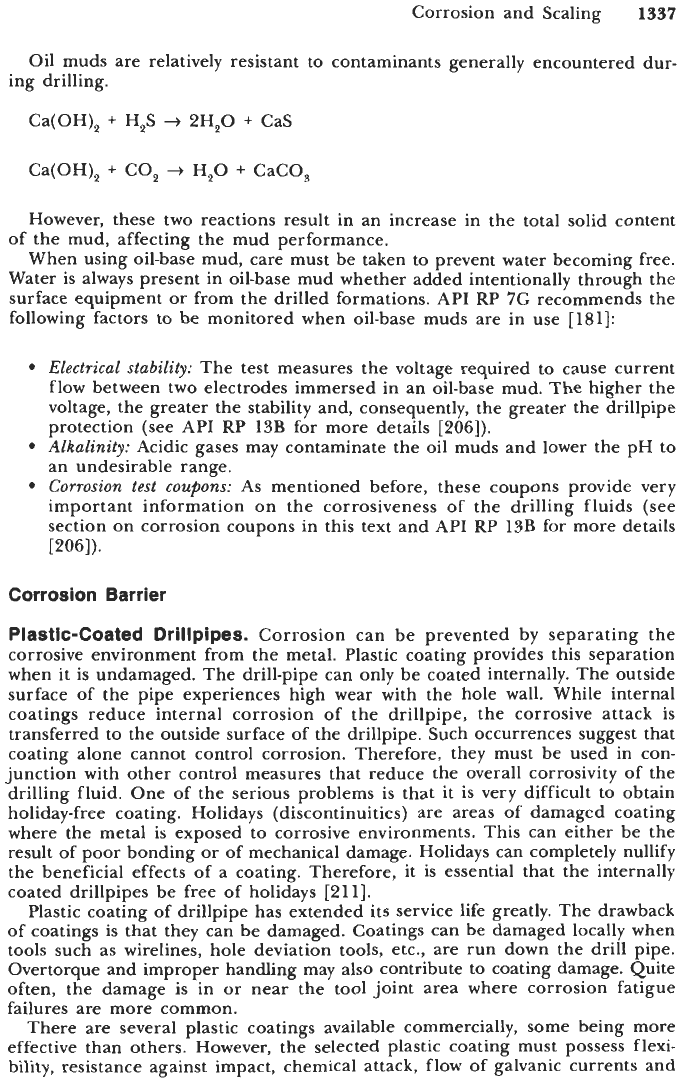
Corrosion and Scaling
1337
Oil muds are relatively resistant to contaminants generally encountered dur-
ing drilling.
Ca(OH),
+
H,S
+
2H,O
+
CaS
Ca(OH),
+
CO,
-+
H,O
+
CaCO,
However, these two reactions result in an increase in the total solid content
of the mud, affecting the mud performance.
When using oil-base mud, care must be taken to prevent water becoming free.
Water is always present in oil-base mud whether added intentionally through the
surface equipment or from the drilled formations. API RP
7G
recommends the
following factors to be monitored when oil-base muds are in use
[181]:
Electrical stability:
The test measures the voltage required to cause current
flow between two electrodes immersed in an oil-base mud. The higher the
voltage, the greater the stability and, consequently, the greater the drillpipe
protection (see API RP
13B
for more details [206]).
Alkalinity:
Acidic gases may contaminate the oil muds and lower the pH to
an undesirable range.
Corrosion
test coupons:
As mentioned before, these coupons provide very
important information on the corrosiveness of the drilling fluids (see
section on corrosion coupons in this text and API RP
13B
for more details
[2061).
Corrosion Barrier
Plastic-Coated Drillpipes.
Corrosion can be prevented by separating the
corrosive environment from the metal. Plastic coating provides this separation
when it is undamaged. The drill-pipe can only be coated internally. The outside
surface of the pipe experiences high wear with the hole wall. While internal
coatings reduce internal corrosion of the drillpipe, the corrosive attack is
transferred to the outside surface of the drillpipe. Such occurrences suggest that
coating alone cannot control corrosion. Therefore, they must be used in con-
junction with other control measures that reduce the overall corrosivity of the
drilling fluid. One of the serious problems is that it is very difficult to obtain
holiday-free coating. Holidays (discontinuities) are areas
of
damaged coating
where the metal is exposed to corrosive environments. This can either be the
result of poor bonding or of mechanical damage. Holidays can completely nullify
the beneficial effects of a coating. Therefore, it is essential that the internally
coated drillpipes be free of holidays [211].
Plastic coating of drillpipe has extended its service life greatly. The drawback
of coatings
is
that they can be damaged. Coatings can be damaged locally when
tools such as wirelines, hole deviation tools, etc., are run down the drill pipe.
Overtorque and improper handling may also contribute to coating damage. Quite
often, the damage is in or near the tool joint area where corrosion fatigue
failures are more common.
There are several plastic coatings available commercially, some being more
effective than others. However, the selected plastic coating must possess flexi-
bility, resistance against impact, chemical attack, flow
of
galvanic currents and
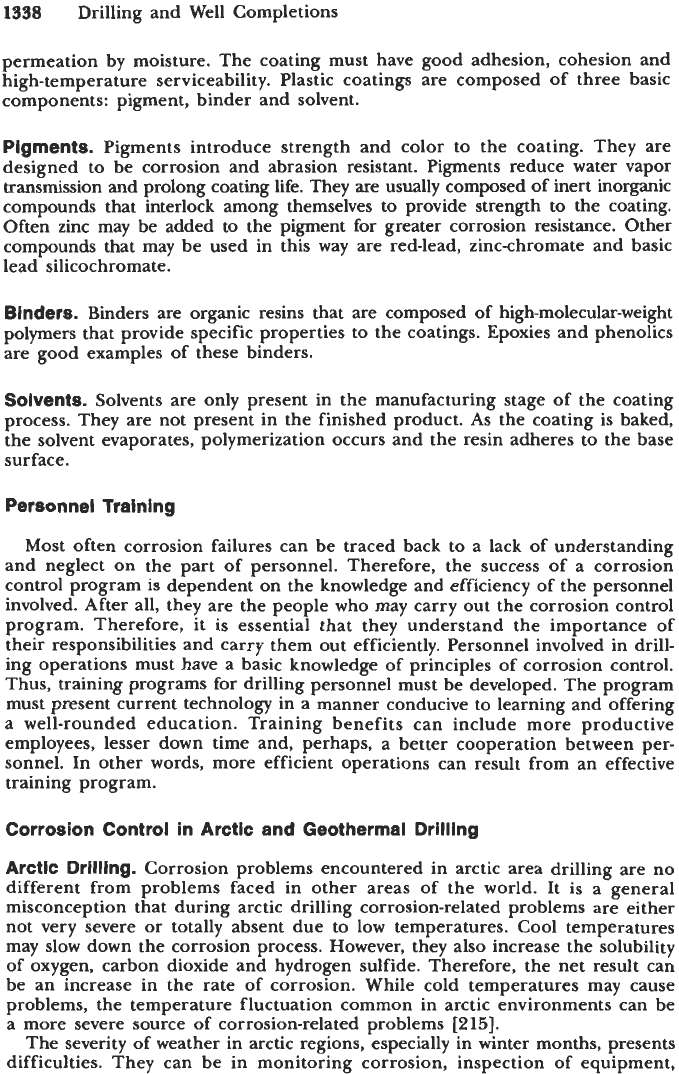
1338
Drilling and Well Completions
permeation by moisture. The coating must have good adhesion, cohesion and
high-temperature serviceability. Plastic coatings are composed of three basic
components: pigment, binder and solvent.
Pigments.
Pigments introduce strength and color to the coating. They are
designed to be corrosion and abrasion resistant. Pigments reduce water vapor
transmission and prolong coating life. They
are
usually composed of inert inorganic
compounds that interlock among themselves
to
provide strength
to
the coating.
Often zinc may be added to the pigment for greater corrosion resistance. Other
compounds that
may
be used in this way are red-lead, zinc-chromate and basic
lead silicochromate.
Binders.
Binders are organic resins that are composed of high-molecular-weight
polymers that provide specific properties to the coatings. Epoxies and phenolics
are good examples of these binders.
Solvents.
Solvents are only present in the manufacturing stage of the coating
process. They are not present in the finished product. As the coating is baked,
the solvent evaporates, polymerization occurs and the resin adheres to the base
surface.
Personnel Training
Most often corrosion failures can be traced back to a lack of understanding
and neglect on the part of personnel. Therefore, the success of a corrosion
control program is dependent on the knowledge and efficiency of the personnel
involved. After all, they are the people who may carry out the corrosion control
program. Therefore, it is essential that they understand the importance of
their responsibilities and carry them out efficiently. Personnel involved in drill-
ing operations must have a basic knowledge of principles of corrosion control.
Thus, training programs for drilling personnel must be developed. The program
must present current technology in a manner conducive to learning and offering
a well-rounded education. Training benefits can include more productive
employees, lesser down time and, perhaps, a better cooperation between per-
sonnel. In other words, more efficient operations can result from an effective
training program.
Corrosion Control in Arctic and Geothermal Drilling
Arctic Drilling.
Corrosion problems encountered in arctic area drilling are no
different from problems faced in other areas of the world. It is a general
misconception that during arctic drilling corrosion-related problems are either
not very severe or totally absent due to low temperatures. Cool temperatures
may slow down the corrosion process. However, they also increase the solubility
of oxygen, carbon dioxide and hydrogen sulfide. Therefore, the net result can
be an increase in the rate of corrosion. While cold temperatures may cause
problems, the temperature fluctuation common in arctic environments can be
a more severe source of corrosion-related problems
[215].
The severity of weather in arctic regions, especially in winter months, presents
difficulties. They can be in monitoring corrosion, inspection of equipment,
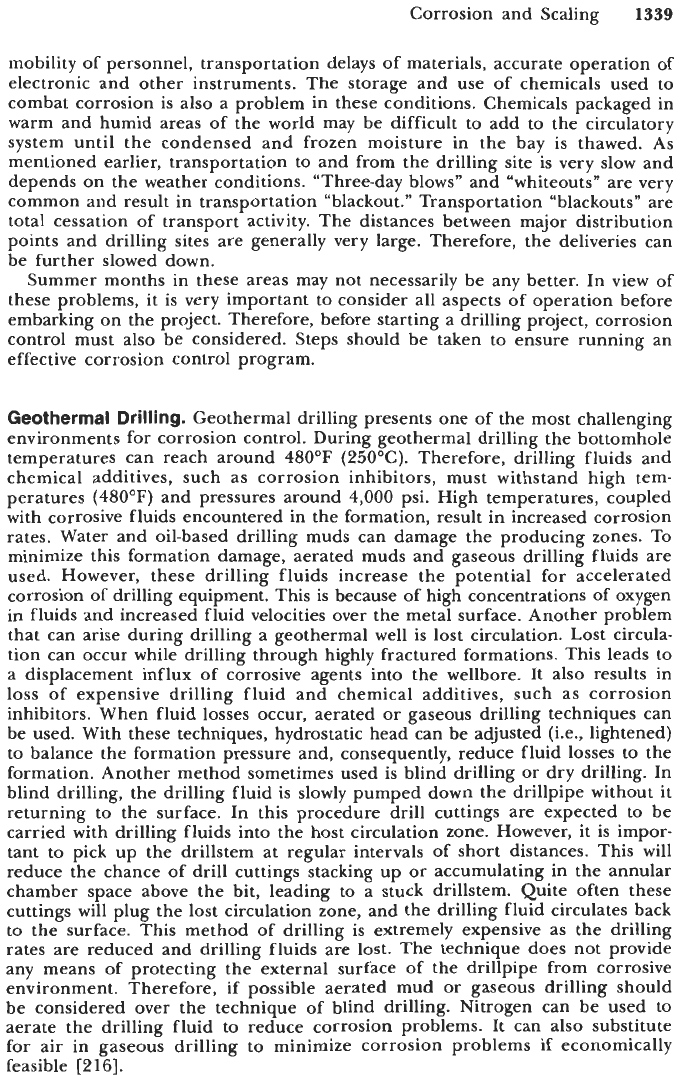
Corrosion and Scaling
1.339
mobility of personnel, transportation delays of materials, accurate operation of
electronic and other instruments. The storage and use
of
chemicals used to
combat corrosion is also
a
problem in these conditions. Chemicals packaged in
warm and humid areas of the world may be difficult to add to the circulatory
system until the condensed and frozen moisture in the bay is thawed. As
mentioned earlier, transportation to and from the drilling site is very slow and
depends on the weather conditions. “Three-day blows” and “whiteouts“ are very
common and result in transportation “blackout.” Transportation “blackouts” are
total cessation
of
transport activity. The distances between major distribution
points and drilling sites are generally very large. Therefore, the deliveries can
be further slowed down.
Summer months in these areas may not necessarily be any better. In view of
these problems, it is very important to consider all aspects of operation before
embarking on the project. Therefore, before starting a drilling project, corrosion
control must also be considered. Steps should be taken to ensure running an
effective corrosion control program.
Geothermal
Drilling.
Geothermal drilling presents one
of
the most challenging
environments for corrosion control. During geothermal drilling the bottomhole
temperatures can reach around
480°F
(250OC). Therefore, drilling fluids and
chemical additives, such as corrosion inhibitors, must withstand high tem-
peratures
(480°F)
and pressures around
4,000
psi. High temperatures, coupled
with corrosive fluids encountered in the formation, result in increased corrosion
rates. Water and oil-based drilling muds can damage the producing zones. To
minimize this formation damage, aerated muds and gaseous drilling fluids are
used. However, these drilling fluids increase the potential for accelerated
corrosion of drilling equipment. This is because of high concentrations of oxygen
in fluids and increased fluid velocities
over
the metal surface. Another problem
that can arise during drilling a geothermal well is lost circulation. Lost circula-
tion can occur while drilling through highly fractured formations. This leads to
a displacement influx of corrosive agents into the wellbore. It also results in
loss
of
expensive drilling fluid and chemical additives, such as corrosion
inhibitors. When fluid losses occur, aerated
or
gaseous drilling techniques can
be used. With these techniques, hydrostatic head can be adjusted (i.e,, lightened)
to balance the formation pressure and, consequently, reduce fluid losses to the
formation. Another method sometimes used
is
blind drilling or dry drilling. In
blind drilling, the drilling fluid is slowly pumped down the drillpipe without it
returning to the surface. In this procedure drill cuttings are expected to be
carried with drilling fluids into the host circulation zone. However, it is impor-
tant to pick up the drillstem at regular intervals of short distances. This will
reduce the chance of drill cuttings stacking up
or
accumulating in the annular
chamber space above the bit, leading to a stuck drillstem. Quite often these
cuttings will plug the lost circulation zone, and the drilling fluid circulates back
to
the
surface. This method of drilling is extremely expensive as the drilling
rates are reduced and drilling fluids are lost. The technique does not provide
any means of protecting the external surface of the drillpipe from corrosive
environment. Therefore, if possible aerated mud or gaseous drilling should
be considered over the technique of blind drilling. Nitrogen can be used to
aerate the drilling fluid to reduce corrosion problems. It can also substitute
for air in gaseous drilling to minimize corrosion problems if economically
feasible
[216].
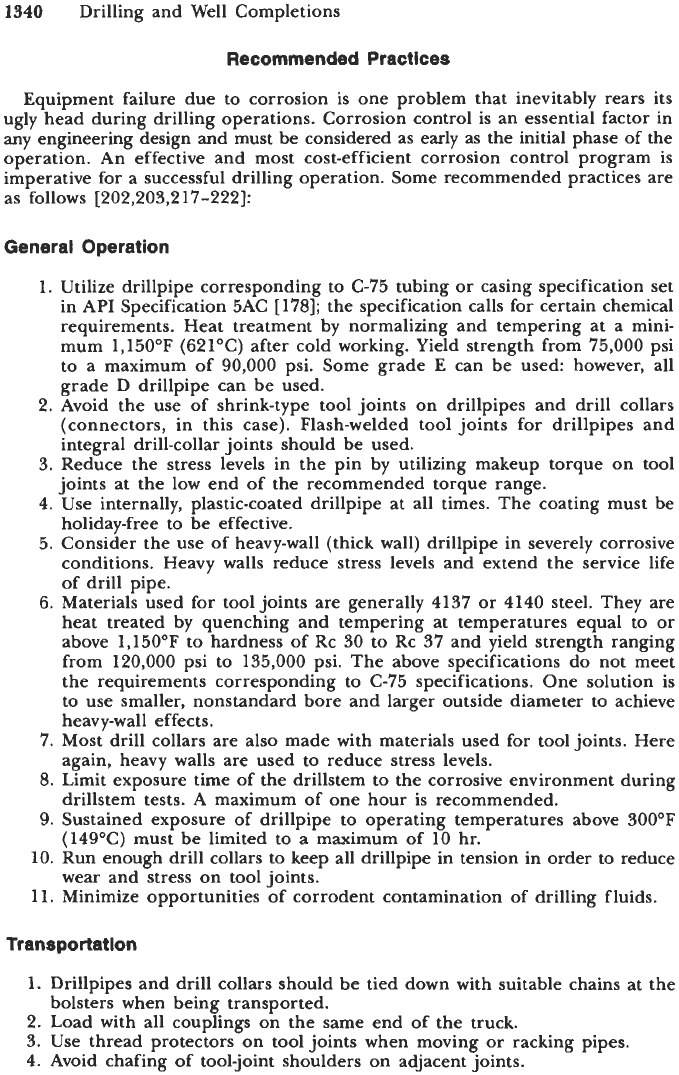
1340
Drilling and Well Completions
Recommended Practices
Equipment failure due
to
corrosion is one problem that inevitably rears its
ugly head during drilling operations. Corrosion control is an essential factor in
any engineering design and must be considered as early as the initial phase of the
operation. An effective
and
most cost-efficient corrosion control program is
imperative for a successful drilling operation. Some recommended practices are
as follows [202,203,217-2221:
General Operation
1.
Utilize drillpipe corresponding to C-75 tubing or casing specification set
in API Specification 5AC
[
1781; the specification calls for certain chemical
requirements. Heat treatment by normalizing and tempering at a mini-
mum 1,150°F (621OC) after cold working. Yield strength from 75,000 psi
to a maximum of
90,000
psi. Some grade
E
can be used: however, all
grade
D
drillpipe can be used.
2.
Avoid the use of shrink-type tool joints on drillpipes and drill collars
(connectors, in this case). Flash-welded tool joints for drillpipes and
integral drill-collar joints should be used.
3. Reduce the stress levels in the pin by utilizing makeup torque on tool
joints at the low end
of
the recommended torque range.
4.
Use internally, plastic-coated drillpipe at all times. The coating must be
holiday-free to be effective.
5. Consider the use of heavy-wall (thick wall) drillpipe in severely corrosive
conditions. Heavy walls reduce stress levels and extend the service life
of drill pipe.
6. Materials used for tool joints are generally 4137
or
4140 steel. They are
heat treated by quenching and tempering at temperatures equal to or
above 1,150"F to hardness of Rc 30 to
Rc
37 and yield strength ranging
from 120,000 psi to 135,000 psi. The above specifications do not meet
the requirements corresponding to C-75 specifications. One solution is
to use smaller, nonstandard bore and larger outside diameter to achieve
heavy-wall effects.
7.
Most drill collars are also made with materials used for tool joints. Here
again, heavy walls are used to reduce stress levels.
8.
Limit exposure time
of
the drillstem to
the
corrosive environment during
drillstem tests.
A
maximum of one hour is recommended.
9.
Sustained exposure
of
drillpipe to operating temperatures above 300°F
(149°C) must be limited to
a
maximum of
10
hr.
10.
Run enough drill collars to keep all drillpipe in tension in order to reduce
wear and stress on tool joints.
11.
Minimize opportunities of corrodent contamination of drilling fluids.
Transportation
1.
Drillpipes and drill collars should be tied down with suitable chains at the
2. Load with all couplings on the same end of the truck.
3.
Use thread protectors on tool joints when moving
or
racking pipes.
4.
Avoid chafing of tool-joint shoulders on adjacent joints.
bolsters when being transported.
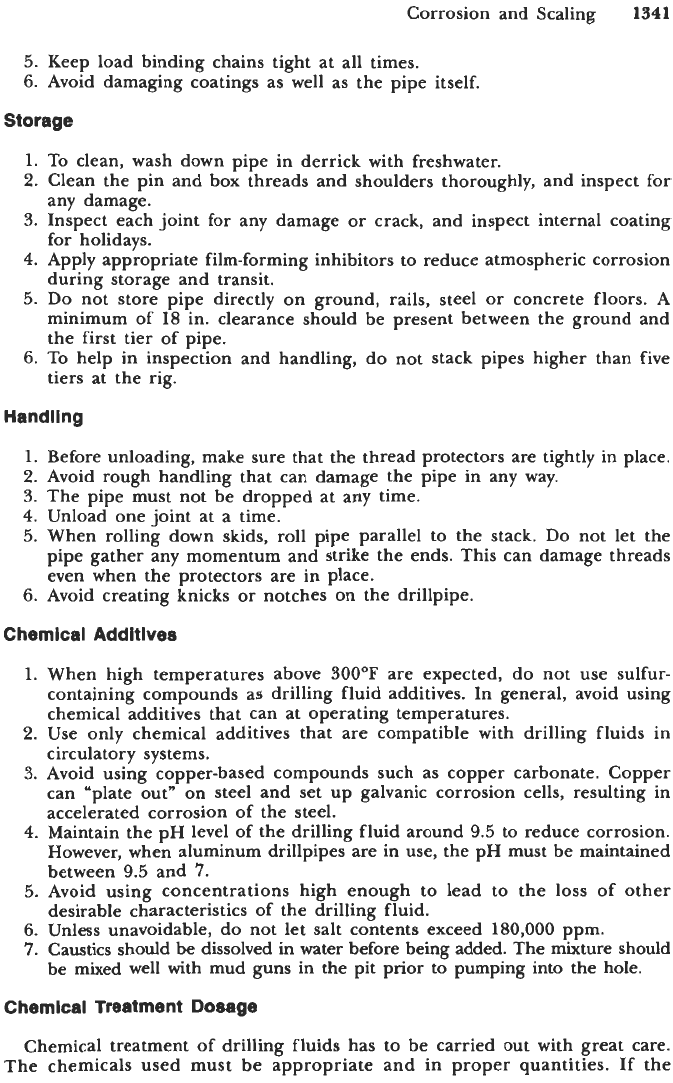
Corrosion and Scaling
1341
5.
Keep load binding chains tight at all times.
6.
Avoid damaging coatings as well as the pipe itself.
Storage
1.
To
clean, wash down pipe in derrick with freshwater.
2.
Clean the pin and box threads and shoulders thoroughly, and inspect for
any damage.
3.
Inspect each joint for any damage or crack, and inspect internal coating
for holidays.
4.
Apply appropriate film-forming inhibitors
to
reduce atmospheric corrosion
during storage and transit.
5.
Do
not store pipe directly on ground, rails, steel
or
concrete floors.
A
minimum of
18
in. clearance should be present between the ground and
the first tier of pipe.
6.
To
help in inspection and handling, do not stack pipes higher than five
tiers at the rig.
Handling
1.
Before unloading, make sure that the thread protectors are tightly in place.
2.
Avoid rough handling that can damage the pipe in any way.
3.
The pipe must not be dropped at any time.
4.
Unload one joint at a time.
5. When rolling down skids, roll pipe parallel
to
the stack.
Do
not let the
pipe gather any momentum and strike the ends. This can damage threads
even when the protectors are in place.
6.
Avoid creating knicks
or
notches on the drillpipe.
Chemical Additives
1.
When high temperatures above
300’F
are expected, do not use sulfur-
containing compounds as drilling fluid additives. In general, avoid using
chemical additives that can at operating temperatures.
2.
Use only chemical additives that are compatible with drilling fluids in
circulatory systems.
3.
Avoid using copper-based compounds such as copper carbonate. Copper
can “plate out” on steel and set up galvanic corrosion cells, resulting in
accelerated corrosion of the steel.
4.
Maintain the pH level of the drilling fluid around 9.5 to reduce corrosion.
However, when aluminum drillpipes are in use, the pH must be maintained
between 9.5 and
7.
5.
Avoid using concentrations high enough to lead to the loss of other
desirable characteristics of the drilling fluid.
6.
Unless unavoidable, do not let salt contents exceed
180,000
ppm.
7.
Caustics should be dissolved in water before being added. The mixture should
be mixed well
with
mud guns in the pit
prior
to
pumping into the hole.
Chemical Treatment Dosage
Chemical treatment of drilling fluids has to be carried out with great care.
The chemicals used must be appropriate and in proper quantities. If the
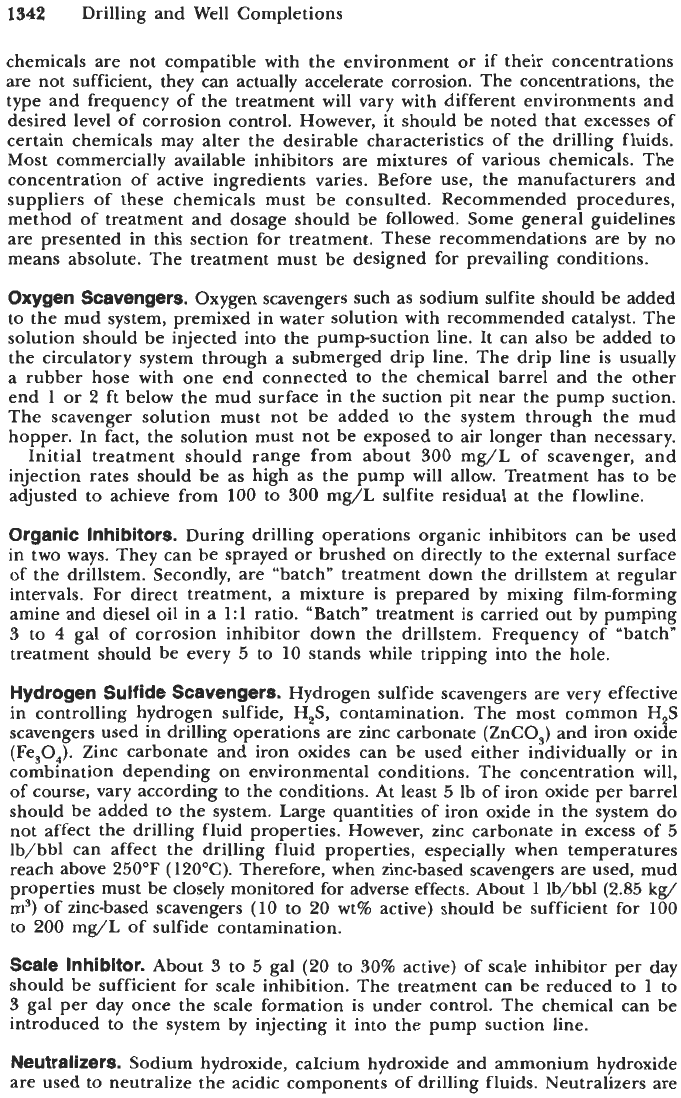
1342
Drilling and Well Completions
chemicals are not compatible with the environment or if their concentrations
are not sufficient, they can actually accelerate corrosion. The concentrations, the
type and frequency of the treatment will vary with different environments and
desired level of corrosion control. However, it should be noted that excesses of
certain chemicals may alter the desirable characteristics of the drilling fluids.
Most commercially available inhibitors are mixtures of various chemicals. The
concentration of active ingredients varies. Before use, the manufacturers and
suppliers of these chemicals must be consulted. Recommended procedures,
method of treatment and dosage should be followed. Some general guidelines
are presented in this section for treatment. These recommendations are by no
means absolute. The treatment must be designed for prevailing conditions.
Oxygen Scavengers.
Oxygen scavengers such as sodium sulfite should be added
to the mud system, premixed in water solution with recommended catalyst. The
solution should be injected into the pump-suction line. It can also be added to
the circulatory system through a submerged drip line. The drip line is usually
a rubber hose with one end connected to the chemical barrel and the other
end 1 or
2
ft below the mud surface in the suction pit near the pump suction.
The scavenger solution must not be added to the system through the mud
hopper. In fact, the solution must not be exposed to air longer than necessary.
Initial treatment should range from about
300
mg/L of scavenger, and
injection rates should be as high as the pump will allow. Treatment has to be
adjusted to achieve from
100
to
300
mg/L sulfite residual at the flowline.
Organic Inhibitors.
During drilling operations organic inhibitors can be used
in two ways. They can be sprayed or brushed on directly to the external surface
of the drillstem. Secondly, are “batch” treatment down the drillstem at regular
intervals. For direct treatment, a mixture is prepared by mixing film-forming
amine and diesel oil in a 1:l ratio. “Batch” treatment is carried out by pumping
3
to
4
gal of corrosion inhibitor down the drillstem. Frequency of ”batch”
treatment should be every
5
to 10 stands while tripping into the hole.
Hydrogen Sulfide Scavengers.
Hydrogen sulfide scavengers are very effective
in controlling hydrogen sulfide,
H,S,
contamination. The most common H,S
scavengers used in drilling operations are zinc carbonate (ZnCO,) and iron oxide
(Fe,O,). Zinc carbonate and iron oxides can be used either individually or in
combination depending on environmental conditions. The concentration will,
of course, vary according to the conditions. At least
5
lb of iron oxide per barrel
should be added to the system. Large quantities of iron oxide in the system do
not affect the drilling fluid properties. However, zinc carbonate in excess of 5
lb/bbl can affect the drilling
f
hid properties, especially when temperatures
reach above 250’F (12OOC). Therefore, when zinc-based scavengers are used, mud
properties must be closely monitored for adverse effects. About
1
lb/bbl (2.85
kg/
m’) of zinc-based scavengers (10 to
20
wt%
active) should be sufficient for
100
to 200 mg/L of sulfide contamination.
Scale Inhibitor.
About
3
to 5 gal
(20
to
30%
active) of scale inhibitor per day
should be sufficient for scale inhibition. The treatment can be reduced to
1
to
3
gal per day once the scale formation is under control. The chemical can be
introduced to the system by injecting it into the pump suction line.
Neutralizers.
Sodium hydroxide, calcium hydroxide and ammonium hydroxide
are used to neutralize the acidic components of drilling fluids. Neutralizers are
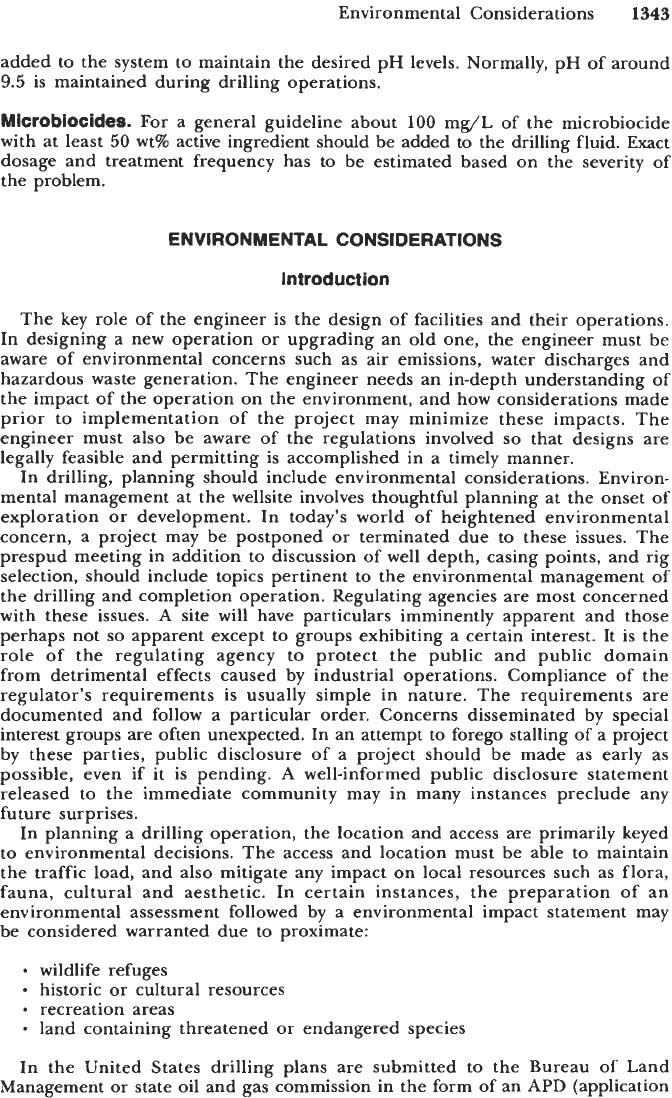
Environmental Considerations
1343
added to the system to maintain the desired pH levels. Normally, pH of around
9.5
is maintained during drilling operations.
Microbiocides.
For
a
general guideline about
100
mg/L of the microbiocide
with at least
50
wt% active ingredient should be added to the drilling fluid. Exact
dosage and treatment frequency has to be estimated based on the severity
of
the problem.
ENVIRONMENTAL CONSIDERATIONS
Introduction
The key role
of
the engineer is the design of facilities and their operations.
In designing a new operation or upgrading an old one, the engineer must be
aware of environmental concerns such as air emissions, water discharges and
hazardous waste generation. The engineer needs an in-depth understanding
of
the impact
of
the operation on the environment, and how considerations made
prior to implementation
of
the project may minimize these impacts. The
engineer must also be aware of the regulations involved
so
that designs are
legally feasible and permitting is accomplished in a timely manner.
In drilling, planning should include environmental considerations. Environ-
mental management at the wellsite involves thoughtful planning at the onset
of
exploration or development. In today’s world of heightened environmental
concern, a project may be postponed or terminated due
to
these issues. The
prespud meeting in addition to discussion of well depth, casing points, and rig
selection, should include topics pertinent to the environmental management of
the drilling and completion operation. Regulating agencies are most concerned
with these issues.
A
site will have particulars imminently apparent and those
perhaps not
so
apparent except to groups exhibiting
a
certain interest. It is the
role of the regulating agency to protect the public and public domain
from detrimental effects caused by industrial operations. Compliance of the
regulator’s requirements is usually simple in nature. The requirements are
documented and follow
a
particular order. Concerns disseminated by special
interest groups are often unexpected. In an attempt to forego stalling
of
a project
by these parties, public disclosure of a project should be made as early as
possible, even if it is pending.
A
well-informed public disclosure statement
released to the immediate community may in many instances preclude any
future surprises.
In planning a drilling operation, the location and access are primarily keyed
to environmental decisions. The access and location must be able to maintain
the traffic load, and also mitigate any impact on local resources such as flora,
fauna, cultural and aesthetic. In certain instances, the preparation
of
an
environmental assessment followed by a environmental impact statement may
be considered warranted due to proximate:
-
wildlife refuges
-
recreation areas
-
land containing threatened
or
endangered species
In the United States drilling plans are submitted to the Bureau of Land
Management or state oil and gas commission in the
form
of an
APD
(application
historic or cultural resources
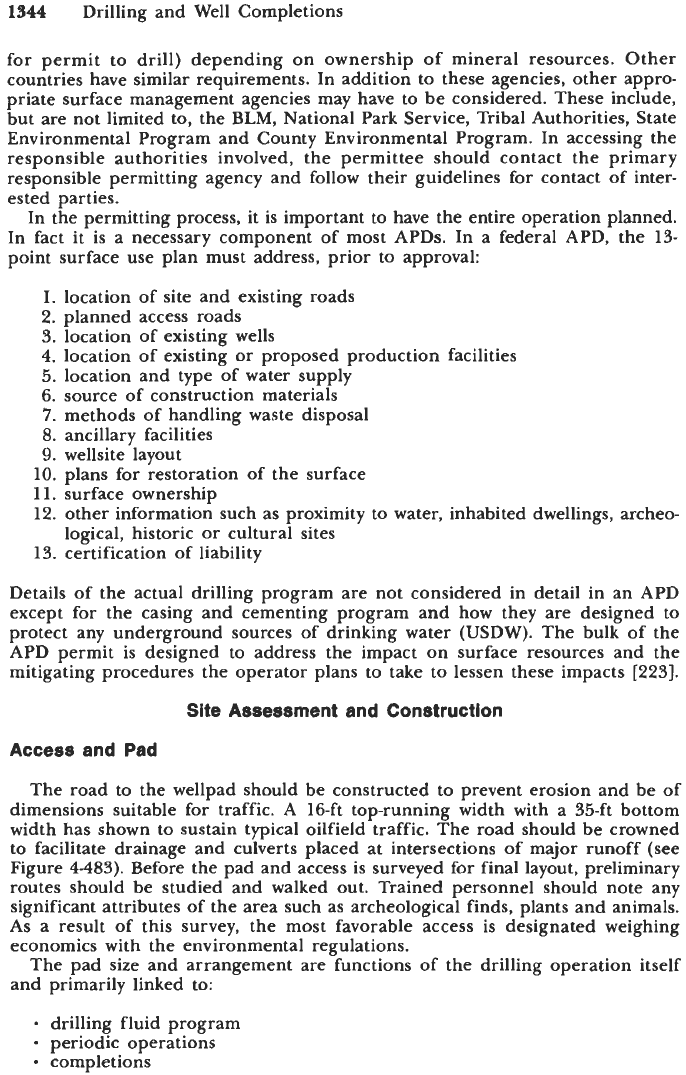
1344
Drilling and Well Completions
for permit
to
drill) depending on ownership of mineral resources. Other
countries have similar requirements. In addition
to
these agencies, other
appro-
priate surface management agencies may have to be considered. These include,
but are not limited to, the
BLM,
National Park Service, Tribal Authorities, State
Environmental Program and County Environmental Program. In accessing the
responsible authorities involved, the permittee should contact the primary
responsible permitting agency and follow their guidelines for contact of inter-
ested parties.
In the permitting process, it is important to have the entire operation planned.
In fact it is
a
necessary component of most
APDs.
In a federal APD, the
13-
point surface use plan must address, prior to approval:
1.
location of site and existing roads
2.
planned access roads
3.
location of existing wells
4.
location of existing or proposed production facilities
5.
location and type of water supply
6.
source of construction materials
7.
methods
of
handling waste disposal
8.
ancillary facilities
9.
wellsite layout
10.
plans
for
restoration of the surface
11. surface ownership
12.
other information such as proximity to water, inhabited dwellings, archeo-
13.
certification of liability
logical, historic
or
cultural sites
Details of the actual drilling program are not considered in detail in an
APD
except for the casing and cementing program
and
how they are designed to
protect any underground sources of drinking water
(USDW).
The bulk of the
APD permit is designed to address the impact on surface resources and the
mitigating procedures the operator plans to take to lessen these impacts
[223].
Site Assessment and Construction
Access
and
Pad
The road to the weIlpad should be constructed to prevent erosion
and
be of
dimensions suitable for traffic.
A
16-ft top-running width with a 35-ft bottom
width has shown
to
sustain typical oilfield traffic. The road should be crowned
to facilitate drainage and culverts placed
at
intersections of major runoff (see
Figure
4-483).
Before the pad and access is surveyed for final layout, preliminary
routes should be studied and walked out. Trained personnel should note any
significant attributes of the area such as archeological finds, plants and animals.
As
a result
of
this survey, the most favorable access is designated weighing
economics with the environmental regulations.
The pad size and arrangement are functions of the drilling operation itself
and primarily linked to:
drilling fluid program
-
periodic operations
-
completions
